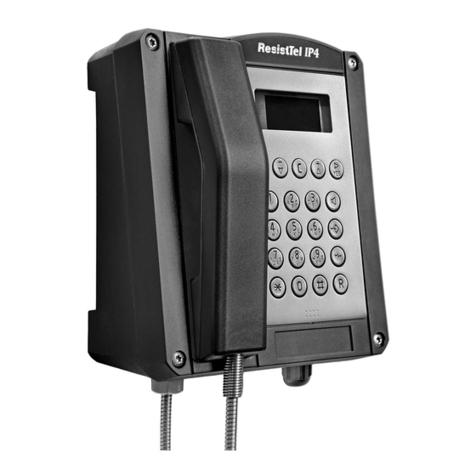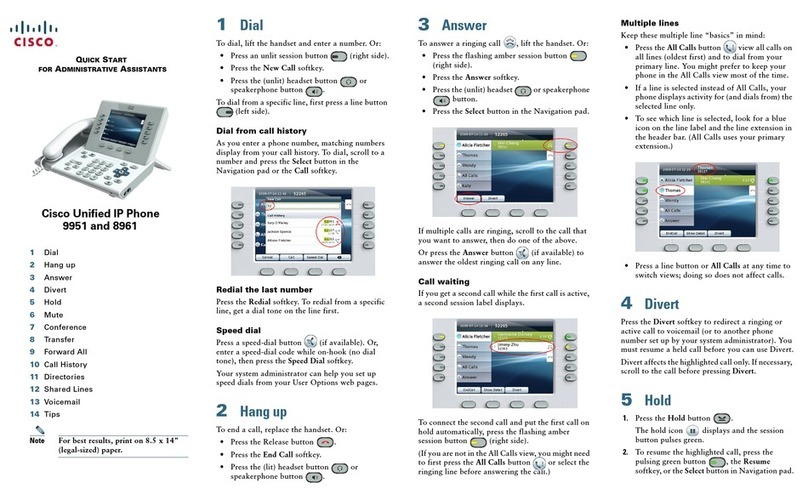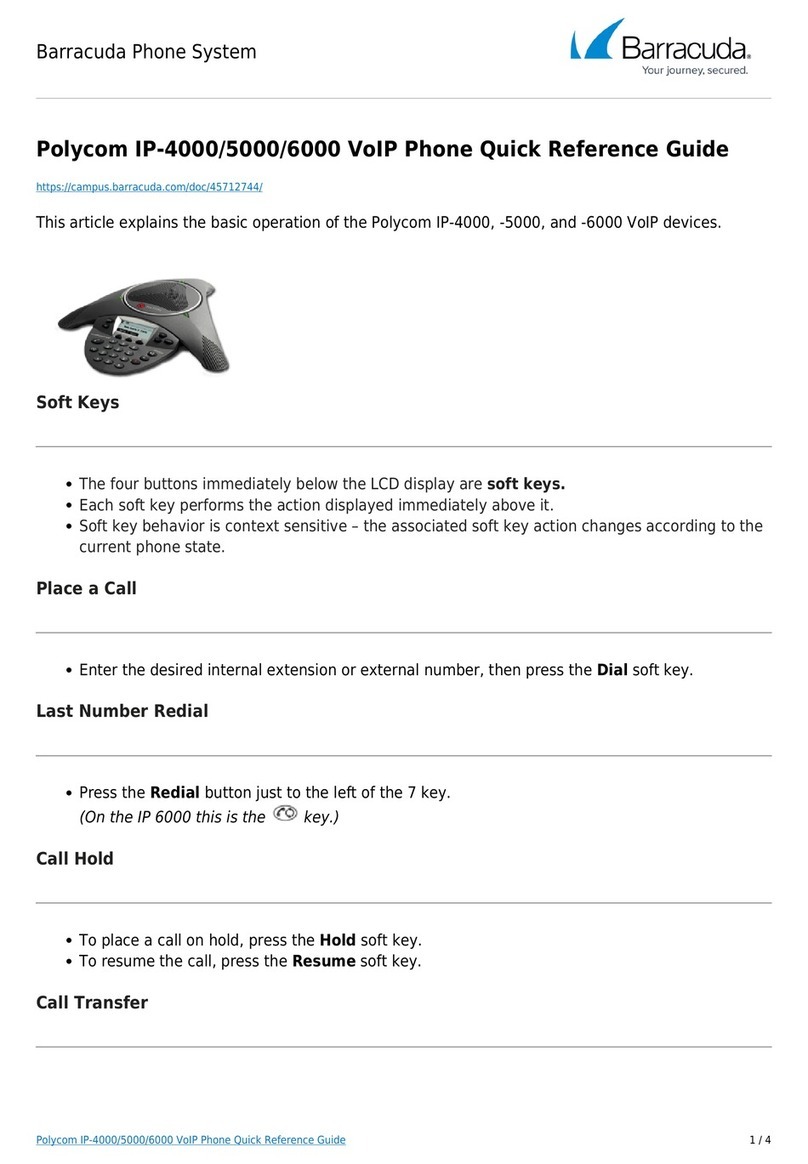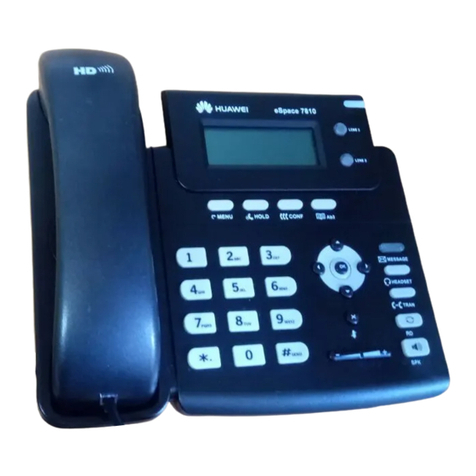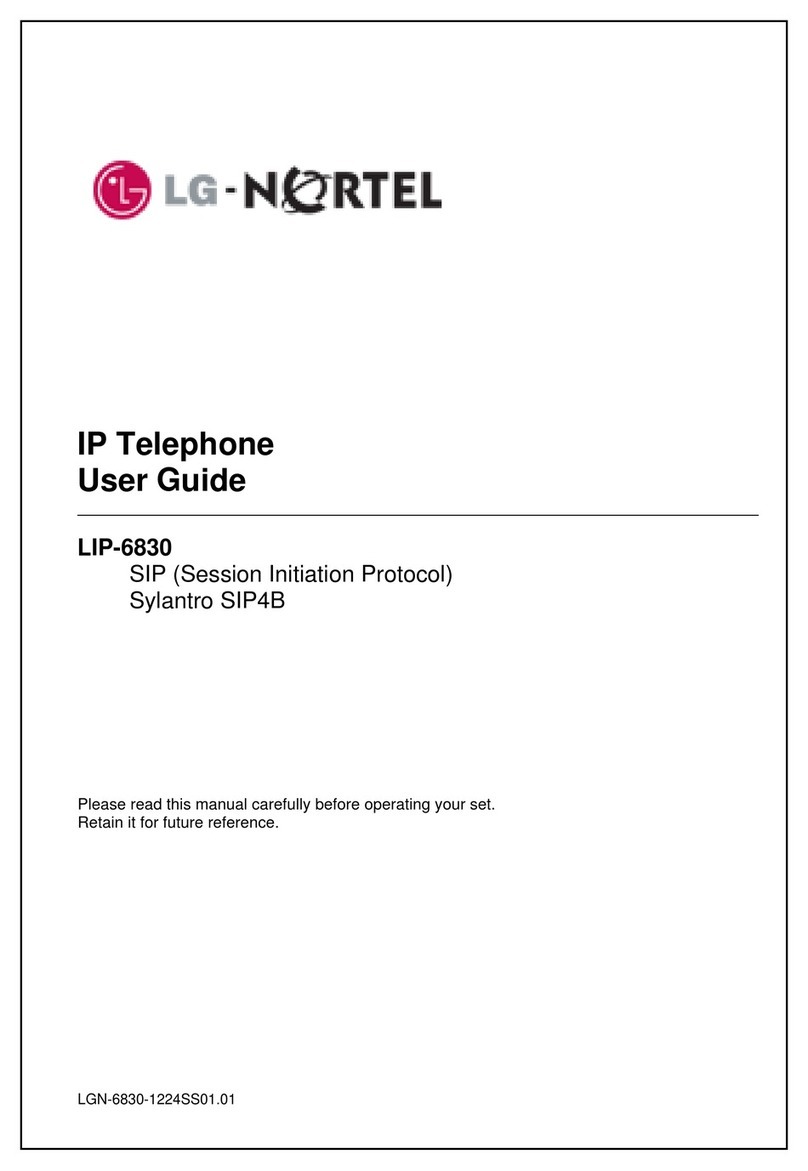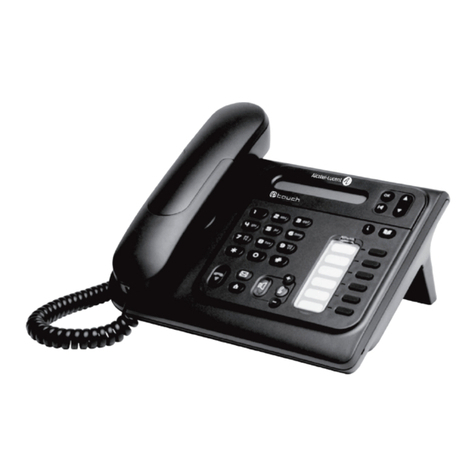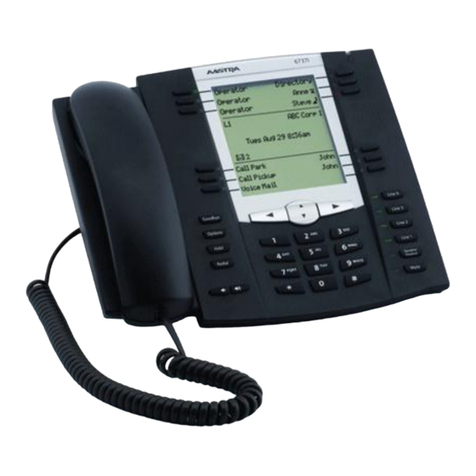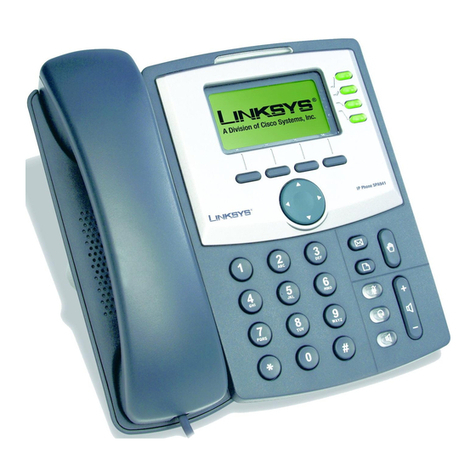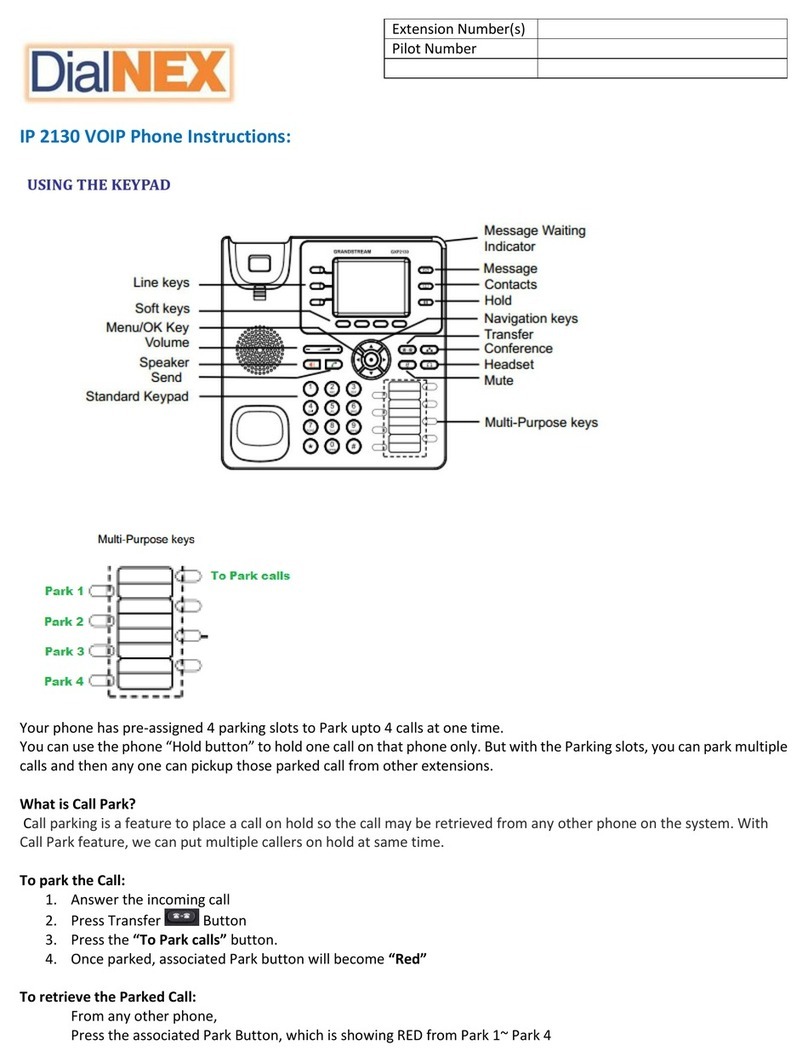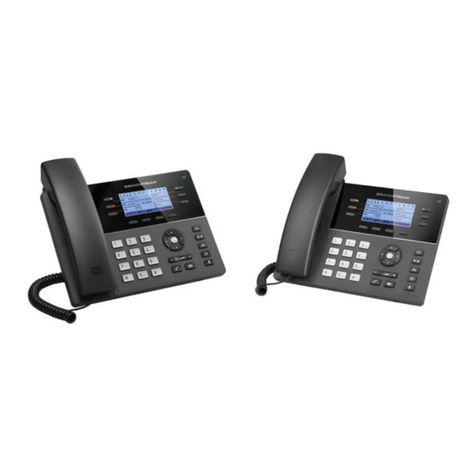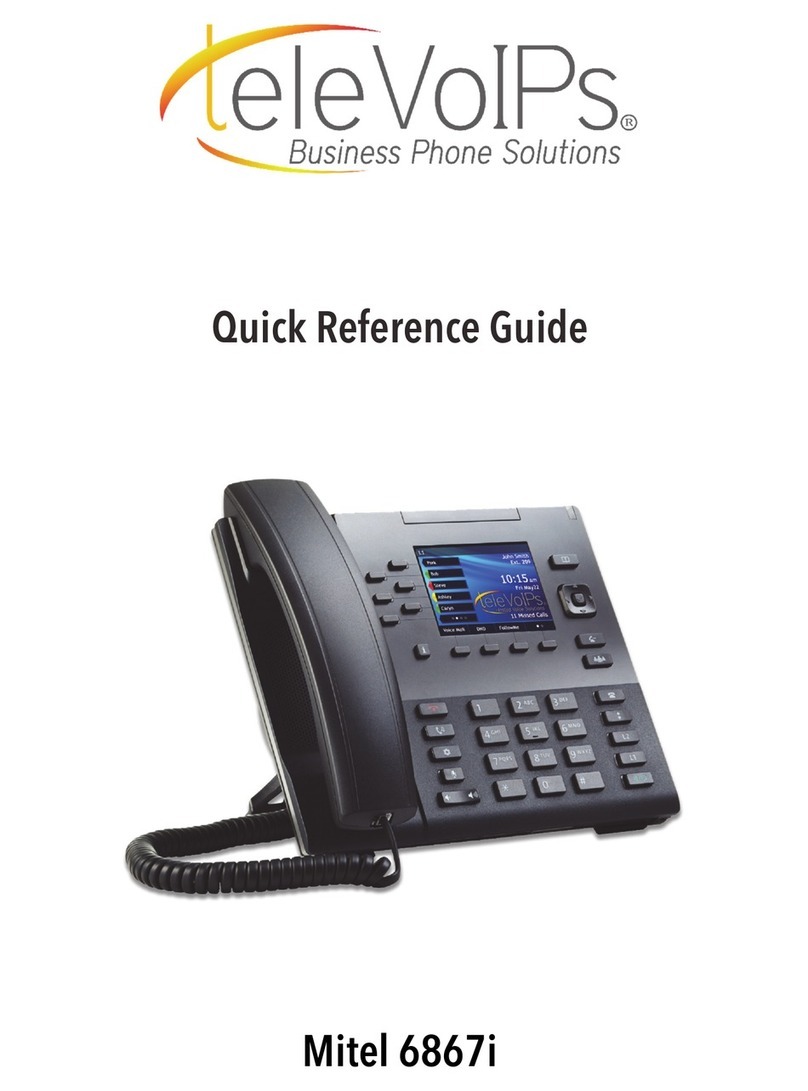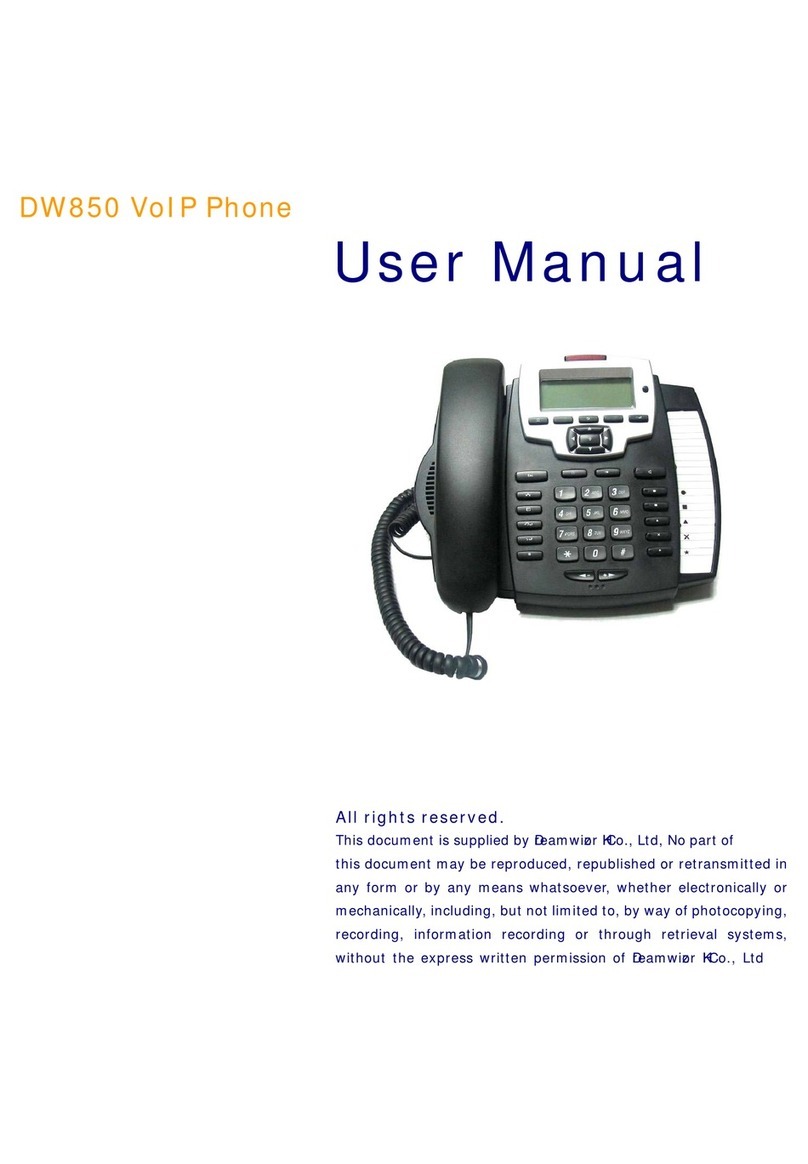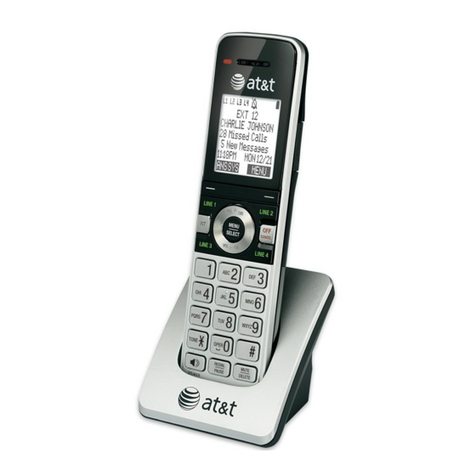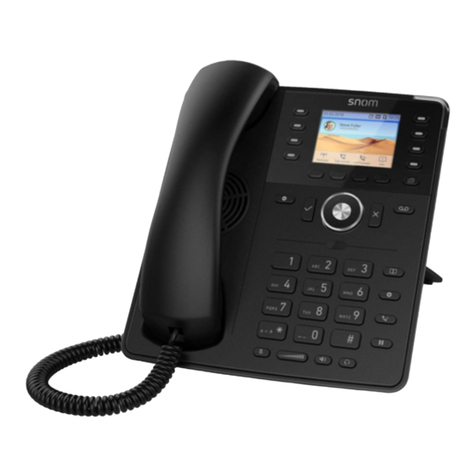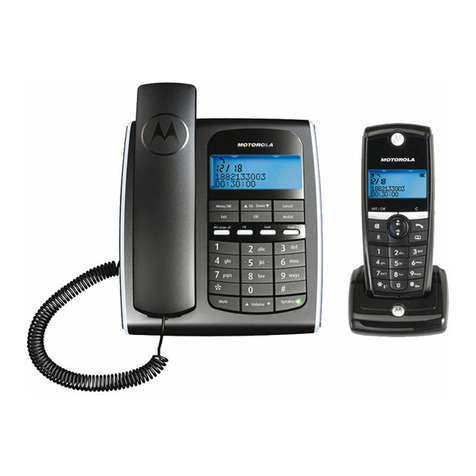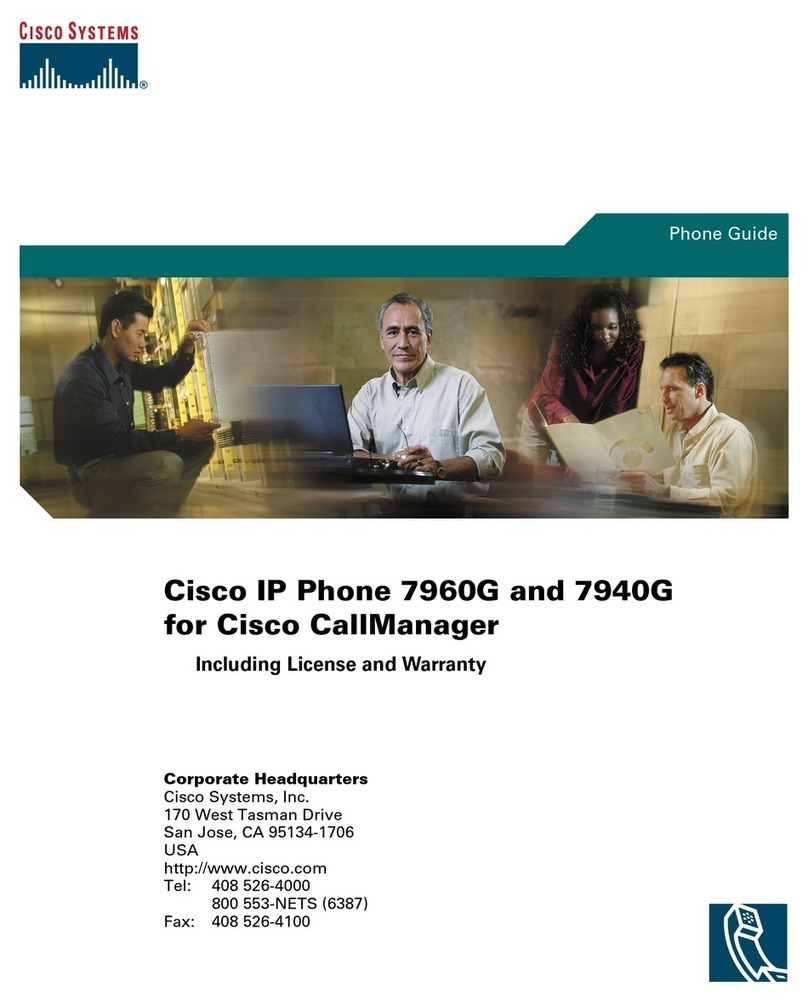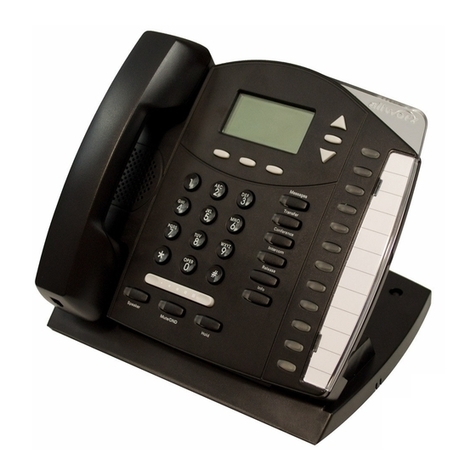Swissvoice Eurit 25 User manual

User guide
Attention:
Please read the instruction manual as well as the
safety precautions before using.
Keep the instruction manual carefully!
Corded ISDN telephone
Eurit 25
feel free at home!

Dear Customer
Thank you for your confidence by choosing our product.
This user manual will help you take full advantage of the features of your Eurit 25 phone.
You will find the following features particularly useful:
– Up to 3 users on the same set, with individual settings
Because the Eurit 25 can handle up to 3 numbers, it is an ideal phone for households with
several members.
The user key enables effortless switching between users. Everyone can immediately find
his or her own number with customised settings.
Each number can be programmed with its own settings, including: ringing melody and
volume, charge accounting per user, various call forwarding options etc.
– Phonebook
Up to 40 numbers and names can be stored in the phonebook.
– Caller list
This list stores the numbers of the last 20 callers who have tried to reach you. The display
indicates the number of unanswered calls.
– Short Message Service (SMS)
You can send and receive SMS messages
– Provider selection
If you want the choice of several providers for telephoning, the Eurit 25 is the right
phone for you. For example, you can program numbers in your phonebook with the
provider prefix so that calls are always routed via the relevant provider.
– A range of advanced features
The Eurit 25 offers 3-way conferencing, callback on busy, and SMS. Added to this,
your phone supports all other ISDN supplementary services.
Please read the safety precautions before starting up your phone, and keep the
User Manual in a safe place!
I

3845 7
6
11
1213141516
910
17
2
1
Overview and operating elements
II

1 Handset hook
2 Loudspeaker key
3 Scroll left (back) in text
4 ESC PE-key
Aborts functions, switches to standby mode.
5 Delete-key (Clear)
6 OK key
Confirms or performs functions etc. Accesses function menu.
7 Mute key
Deactivates the handset microphone so that the calling partner cannot hear.
8 User key
Change user.
9 Menu key
Opens access to main menu.
Scroll right (forward) in te t
10 LED status display
11 Emergency mode switch
12 Speed dial keys
13 Dialling keypad, alphanumeric entry
14 Plus key
Loudspeaker volume up.
15 R key (enquiry key)
16 Redial key
17 Minus key
Loudspeaker volume down.
LED status display
The LED indicates the status of your phone
LED lit: »Unconditional call forwarding« or »Ringing tone off« (ringing volume
set to zero) has been activated by at least one user.
LED flashing: Incoming call with ringing tone volume set to zero (»Ringing tone off«),
or incoming short te t messages (SMS).
LED unlit: Normal mode.
Overview and operating elements
III

1
203231631en_ba_b0
Contents
Eurit 25
The Eurit 25 is designed for connection to the public ISD network.
If you plan to use the Eurit 25 in conjunction with a PBX, please refer to the section
on »PBX access«.
Please read this user manual carefully to learn about the benefits of your new Eurit 25
and get the maximum use from them.
Keep this user manual in a safe place!
Important information on your ISDN connection
This user manual describes all the functions for which you must apply your network
provider. Some of these functions are provided at a charge.
The range of services available to you depends on the connection type.
For further information on the services available via your ISD connection, contact your
network provider.
Contents
Overview and operating elements ...................................................................................... II
LED status display .................................................................................................................III
Introduction ........................................................................................................................... 5
The phone............................................................................................................................ 5
User manual ......................................................................................................................... 6
How to proceed ................................................................................................................... 7
Startup.................................................................................................................................... 8
Unpacking the phone ........................................................................................................... 8
Positioning ........................................................................................................................... 9
Connecting the phone ......................................................................................................... 9
Write-on label .................................................................................................................... 10
The display ......................................................................................................................... 11
Display symbols .................................................................................................................. 12
Using the function menu .................................................................................................... 13
Setting up Multiple Subscriber umbers (MS )................................................................... 14
Telep oning ......................................................................................................................... 16
User concept ...................................................................................................................... 16
Manual dialling .................................................................................................................. 17
Call back on busy / no reply................................................................................................ 18

2
203231631en_ba_b0
Contents
Redialling ........................................................................................................................... 19
Dialling from the phonebook.............................................................................................. 20
Dialling numbers in the caller list ........................................................................................ 22
Dialling numbers in the call log........................................................................................... 2
Speed dialling..................................................................................................................... 26
Provider selection ............................................................................................................... 27
Listening by loudspeaker .................................................................................................... 28
Setting the volume ............................................................................................................. 28
Microphone off ..................................................................................................................28
Parking a call ...................................................................................................................... 29
Incoming calls .................................................................................................................... 31
ETV® Online (only for Switzerland) ...................................................................................... 32
Conducting two calls/switching between calls .................................................................... 35
Transferring calls................................................................................................................. 37
Three-party conference....................................................................................................... 38
Call forwarding .................................................................................................................. 0
Direct call ........................................................................................................................... 1
Phonebook ........................................................................................................................... 42
Entering number and name only ........................................................................................ 3
Assigning options to numbers ............................................................................................ 5
Changing entries ................................................................................................................ 8
Deleting entries .................................................................................................................. 50
Additional settings .............................................................................................................. 51
Enter additional users (MSN)............................................................................................... 51
Programming speed dial keys ............................................................................................. 5
Setting the date and time ................................................................................................... 57
Interception circuit (malicious call identification) ................................................................. 57
CLIR Calling Line Identification Restriction .......................................................................... 58
Reject all anonymous calls .................................................................................................. 59
Deactivating call waiting..................................................................................................... 59
Setting the ringing tone melody and volume ...................................................................... 60
Ascending ringing volume .................................................................................................. 61
Setting the language .......................................................................................................... 61
Setting the charge factor and currency ............................................................................... 62
Individual user charges, call charge total ............................................................................. 63
Setting the contrast ............................................................................................................6

3
203231631en_ba_b0
Contents
S ort Message Service (SMS) ............................................................................................. 65
Incoming SMS signalling..................................................................................................... 67
Handling incoming SMS messages...................................................................................... 68
Write, send, save SMS messages ........................................................................................ 70
Retrieve, send, delete saved SMS messages ........................................................................ 71
PBX access ............................................................................................................................ 72
PBX access on/off ...............................................................................................................72
Entering the Exchange Access Code (EAC) for outgoing calls .............................................. 73
Entering EAC for incoming calls.......................................................................................... 74
Internal number length....................................................................................................... 75
Setting the transfer type ..................................................................................................... 76
Keypad information............................................................................................................ 78
Send automatic keypad on/off............................................................................................ 79
Attac ment .......................................................................................................................... 80
Renumbering .....................................................................................................................80
Emergency operation ......................................................................................................... 81
Resetting the phone ........................................................................................................... 82
Headset connection............................................................................................................ 82
Show software version and checksums ............................................................................... 83
PC dialling option (Eurit Office Tool) ................................................................................... 83
Remote download .............................................................................................................. 84
Troubleshooting .................................................................................................................85
Care ................................................................................................................................... 85
Summary of default settings ............................................................................................... 86
Technical Data .................................................................................................................... 87
Safety tips .......................................................................................................................... 87
Warranty Conditions .......................................................................................................... 88
Disposal ............................................................................................................................. 88
Approval and CE code ........................................................................................................ 88
Liability............................................................................................................................... 88
Declaration of conformity ................................................................................................... 89
Menu structure ..................................................................................................................90
Write-on labels ................................................................................................................... 93
Warranty Certificate ............................................................................................................95
Key words ............................................................................................................................ 97
Notes .................................................................................................................................... 99

4
203231631en_ba_b0

5
203231631en_ba_b0
Introduction
T e p one
Connection type
Your phone is designed for use with an ISD basic access (DSS1 protocol, Euro-ISD ) and can
be operated on your subscriber connection ( TBA), an ISD bus (S-Bus) or connected to a PBX.
The phone is powered via the TBA power supply or the PBX. In the event of a power failure, a
backup supply powers the phone via the local exchange (for PBX operation, refer to the PBX
documentation).
User concept
Every user can define his or her own settings. Separate call charges are recorded for each user
(for details on the user concept, see »User concept« in the section on »Telephoning«).
Advanced features
Your dynamically managed phonebook can store up to 40 numbers.
Four speed dial keys, each for two numbers, allow you to dial numbers simply by pressing a key.
A wide range of user-friendly features make your new phone easy to operate and enhances
calling comfort. For a summary of these features, see the contents list.

6
203231631en_ba_b0
Introduction
User manual
This user manual will help you get to know all the functions of your ISD phone. Keep the
instructions near your phone.
The contents list and comprehensive list of key words will help you to find what your are
looking for quickly.
Structure of user manual
The individual sections contain a full description of the functions. There is no need to leaf
through the entire book to find out about an operating procedure.
Firstly, general information on the function is given. Then the procedure is described step by
step. The left margin displays the keys to be activated. To the right of this you will find
information on the procedure and the associated display.
The text may be followed by a comments section:
➭
This provides general information or tips and tricks which further simplify the use of your
phone.
Pictograms
Generally the operating steps are accompanied by the keys to be activated. For procedures
which do not require keys or where the key covers several functions, the following pictograms
are used:
Any entry via the keypad.
Lift the handset.
Replace the handset.
Or… This comment appears in the left key margin to indicate alternatives.
…Continue This appears in the left key margin after an alternative action to indicate that
the procedure should be continued from this point.

7
203231631en_ba_b0
Introduction
How to proceed
Read the section on »Startup« first.
If you plan to use the phone in conjunction with a PBX, please refer to the Section on »PBX
access«.
Look up the procedure/function in the contents or key words list. Go to the relevant page and
follow the instructions.
If you encounter problems, press the ESCAPE key briefly to go back one step in the menu or
hold the ESCAPE key down longer to abort the function. Repeat the step again or refer to the
section on »Troubleshooting«.
Enjoy getting to know your phone!

8
203231631en_ba_b0
Startup
Your feature-rich Eurit 25 phone will only function to your satisfaction if you meet all the
requirements for startup.
Unpacking t e p one
Contents of t e package
1 Eurit 25 phone
1 handset
1 handset cord
1 connection cord
1 operating manual
C ecking t e contents of t e package
Before you set up and connect your Eurit 25, check the contents of the package carefully for
• damage to the actual packaging, which may indicate that the phone has been damaged in
transit!
• visible damage to the handset or phone!
• damage to the connection cords, e.g. to the connectors or cable sheathing!
➭
Under no circumstances must the phone be put into operation if damaged! If in doubt,
contact your dealer.
➭
Please keep the original packaging. You can use it for transporting the phone during
moves or sending in the phone for repairs.

9
203231631en_ba_b0
Startup
Positioning
Place the Eurit 25 on an even, dry surface within range of the connection socket ( TBA or
wall socket). If the selected position is too far from the connection socket, use an approved
extension cable which you can buy from a specialist dealer.
The phone is designed for normal operating conditions. Modern furniture features a wide range
of varnishes and plastic veneers and is treated with a large number of different polishes. Some
of these agents may contain ingredients that corrode and soften the plastic feet of the phone.
If this happens, it may leave undesirable marks on the furniture surface. Understandably, the
producer cannot accept any liability for such damage.
➭
ake sure the telephone connection cord is safely stowed to prevent tripping on it.
➭
Do not plug the connection cord in sockets other than the one for which it is intended.
Connecting t e p one
The connection sockets for the handset and connection cord are located on the base of the
phone. Connect the handset first, then plug the phone in to the jack.
Connecting t e andset
The connectors at both ends of the spiral cord are the
same size.
Plug the connector at the longer, straight end of the cord
into the socket on the phone base (1) marked with the
handset symbol.
Press the cable into the cable duct (2). To do this, use a
flat, thin object to press the cord under the grips.
Plug the connector at the other end of the spiral cord into
the socket on the handset (3).

10
203231631en_ba_b0
Startup
Connecting t e p one
Plug the smaller of the two connectors on the
telephone connection cord into the socket on the
phone base (1) marked with the phone symbol.
Press the cable into the cable duct (2). To do this,
use a flat, thin object to press the cord under the
grips.
Turn the phone over again and set it on its feet. Lift
the handset.
Plug the larger connector at the other end of the
telephone connection cord into the wall socket (3)
or TBA.
The display shows »Please enter at least one MS
(subscriber number) with name>OK<«. To set up
multiple subscriber numbers or MS s, refer to the
section on »Setting up Multiple Subscriber
umbers (MS )«.
Lift the handset. You will hear the dialling tone. ow you can start telephoning!
➭
ake sure the telephone connection cord is safely stowed to prevent tripping on it.
➭
Do not plug the connection cord in sockets other than the one for which it is intended.
Write-on label
The phone is delivered with the write-on label already
inserted.
The last page of this user manual contains additional labels
for the speed dial keys. Cut a new label out whenever you
need one.
Insert the cut-out label into the recess near the speed dial
keys (1). If you already know which numbers are to be
assigned to these keys, you can complete the label now.
Place the Perspex cover on the label field into the recess (2)
and press lightly until it fits into position.
➭
If you want to add other numbers or do not know at startup which numbers you will be
using, you can easily remove the Perspex cover for subsequent modification. Lift the cover
by placing a fingernail under the notch at its edge. Add the number(s) and replace the
cover as described above.
2
1

11
203231631en_ba_b0
Startup
T e display
Your Eurit 25 is equipped with a display which shows various pictograms indicating the menu
function/status as well as a text line with explanatory text.
The display is always active to indicate the status of your phone.
Standby display
The standby display indicates the status of your phone.
Status symbols in standby mode (shown in example:
user code)
Time
Date or current call
If unanswered calls have been registered, the date
display disappears and is replaced by the call count.
Function display
The pictogram line shows the current status (e.g. user)
or menu position.
The text line shows the current function, menu or sub-
menu. Use the menu key and left arrow key to scroll
through menu functions and press the OK key to
confirm your selection.
The arrow keys are also used to select a specific entry
position e.g. for entering names via the keypad.

12
203231631en_ba_b0
Startup
Display symbols
User codes from A to C
TEXT MODE – The keypad is in text mode i.e. letters rather than numbers can
be entered.
DIRECT CALL – The direct call is activated (lift handset and press any key).
CALL BACK – One or more call backs (on busy or no answer) are activated. The
symbol disappears only when all call backs are deactivated. A flashing symbol
indicates an automatic call back which you can activate by pressing OK.
CALL FORWARD – One or more call forwards have been activated. The symbol
disappears only when all call forwards are deactivated.
LOUDSPEAKER – The loudspeaker is active.
MICROPHO E – The microphone is switched off (microphone mute).
SUPPRESS O. – Your own (outgoing) number is suppressed i.e. it is withheld
from the person you are calling.
HEADSET – The headset is activated.
RI GI G TO E OFF – The loudspeaker is switched off (i.e. ringing volume = 0).
MWI – Your phone can evaluate special signalling (MWI).
CALLER LIST – List of unanswered calls to your Eurit 25.
SHORT MESSAGE SERVICE (SMS) - You have SMS messages waiting on your
Eurit 25.
I COMI G SMS MESSAGES
U SE T SMS MESSAGES
PROVIDER – calls are routed via a preset provider.
P

13
203231631en_ba_b0
Startup
Using t e function menu
Operation of your Eurit 25 is menu-guided.
To call up menus and scroll through sub-menus, you have two options:
Menu key
If the display is in default mode (standby) and the handset is on-hook, press the
menu key to access the first main menu »Phonebook«. Press the menu key
again repeatedly to scroll through the main menus.
Once you reach the end of the main menu list, press the menu key again to go
back to the top.
Press the OK key to confirm the selected main menu.
OK key and arrow keys
The OK key is in the centre of the keypad under the
display.
Press this key to confirm the menu or the item you have
selected using the arrow keys.
The left arrow key (<) takes you back one step in the
current menu. The right arrow key (<) takes you forward
one step in the current menu. The arrow keys are used
to select menus, change the entry position or set the
volume.
Escape key
Press the ESCAPE key briefly to switch back one menu level, hold down to exit
the selected menu or abort a function. The display returns to the default mode
(standby).
➭
enus or functions you are currently in are aborted by incoming calls or can be exited by
lifting the handset or pressing the loudspeaker button.

14
203231631en_ba_b0
Setting up Multiple Subscriber Numbers (MSN)
When applying for your ISD connection from your network provider, you will have received at
least three numbers for your connection (Your Eurit 25 supports 3 numbers). These numbers
can be assigned to different devices or programmed on your Eurit 25 as user-specific numbers
(MS ). For example, a different ringing tone melody can be set for different MS s.
If you have not set an MS for your phone, it will ring whenever any of the assigned numbers is
called, even if you have assigned one of them to another device e.g. a fax machine.
To get the best out of your Eurit 25, you must set at least one user. This is done automatically
by giving the phone an MS . See the section on »Additional settings« for how to assign other
users.
➭
You cannot assign the same SN to several users.
Programming t e multiple subscriber number (MSN) on startup
The display shows the following text: »Please enter at least one MS (subscriber number) with
name>OK<«.
Press the OK key. »Set MS « appears.
Press the OK key again. The display shows »MS A«.
You can use the arrow keys to scroll between the three possible MS s (A, B or
C). Go back to the »MS A« display.
Press the OK key again. The display shows » o._« with the cursor position.
Using the keypad, enter one of the MS s assigned to you by your network
provider. Enter the number with prefix.
If you have entered the number incorrectly, press the left arrow key (<) until the
cursor position reaches the error. Enter the correct number to overwrite the
incorrect one and press the right arrow key (>) until you reach the end of your
entry.
Press the OK key. The display shows » ame_« with the entered number. The
phone is now in text mode. If you do not want to enter a name, the current
display remains until you press the OK key.
Or…
Startup

15
203231631en_ba_b0
Startup
You can enter the name of user A. Press the key containing the letter or
character you wish until the letter appears, e.g. for K, press key 5 twice. Press
the # key to switch between upper and lower case lettering.
In the case of double letters or if the following letter is on the same key, wait
briefly before pressing the key again. Proceed as above for every letter you
need.
If you have entered a letter incorrectly, press the left arrow key (<) until the
cursor position reaches the error. Enter the correct letter to overwrite the
incorrect one and press the right arrow key (>) until you reach the end of the
text. The following letters and characters are available on the keys in text
mode:
- . ? ! , : ; ’ “
A B C a b c Ä Ã Å Æ Ç ä à á â ã å æ ç
D E F d e f É è é ê ë
G H I g h i ì í î ï
J K L j k l
M O m n o Ö Ñ Ø ö ñ ò ó ô õ ø
P Q R S p q r s ß
T U V t u v Ü ü ù ú û
W X Y Z w x y z ÿ
Space # +
* /( ) < = > % & @ $ °
Upper/lower case
…Continue
Once you have entered the name or if you do not wish to enter a name, press
the OK key. A short acoustic signal indicates that the MS has been saved
successfully. »MS A« appears in the display. For additional MS s, press the
right arrow key to select the MS to be assigned. Continue from the third
operating step described above.
If you do not wish to assign additional MS s and program other users, press
the ESCAPE key. The display returns to default mode.
➭
If you have not entered any user names, the number is regarded as the user name.
➭
Once the SN has been set, your phone only rings when this number is called.

16
203231631en_ba_b0
Telephoning
This section describes the various options your Eurit 25 offers on the ISD connection. All
options listed here are valid for all users you have assigned to the phone. See »Additional
settings« for how to assign three different users. This describes the different settings which
can be made for different users.
Your Eurit 25 can also be operated in conjunction with a PBX with the same options as listed
below. The range of additional features available to you and how you use them is dependent
on the PBX type. See »PBX access« in the Attachment for how to connect your phone to a PBX.
➭
All options listed below assume that at least one SN ( ultiple Subscriber Number) and
one user has been set, as described in the section on »Startup«.
User concept
The Eurit 25 allows you to assign three different users to a single phone. For example, if you
use the phone at home you can set it for the following users: »Mother«, »Father«, and
»Daughter«, or for business purposes for »Company«, »Club« and »Private«. You can switch
from one user to another by pressing the user key. The display shows the active
user’s code (A, B, C).
Once you have defined the relevant settings for each user, your Eurit 25 handles various
functions individually depending on the set user.
For every call the active user makes, his number is presented to the called party. Incoming calls
are distinguished from outgoing calls and displayed in the caller list. The phone calculates the
charges separately for each user. Calls can be diverted according to the user’s requirements etc.
➭
The detailed procedure for setting different users is described in the Section on »Additional
settings« under »Entering additional users«.
Table of contents
Other Swissvoice IP Phone manuals

Swissvoice
Swissvoice IP 20 User manual
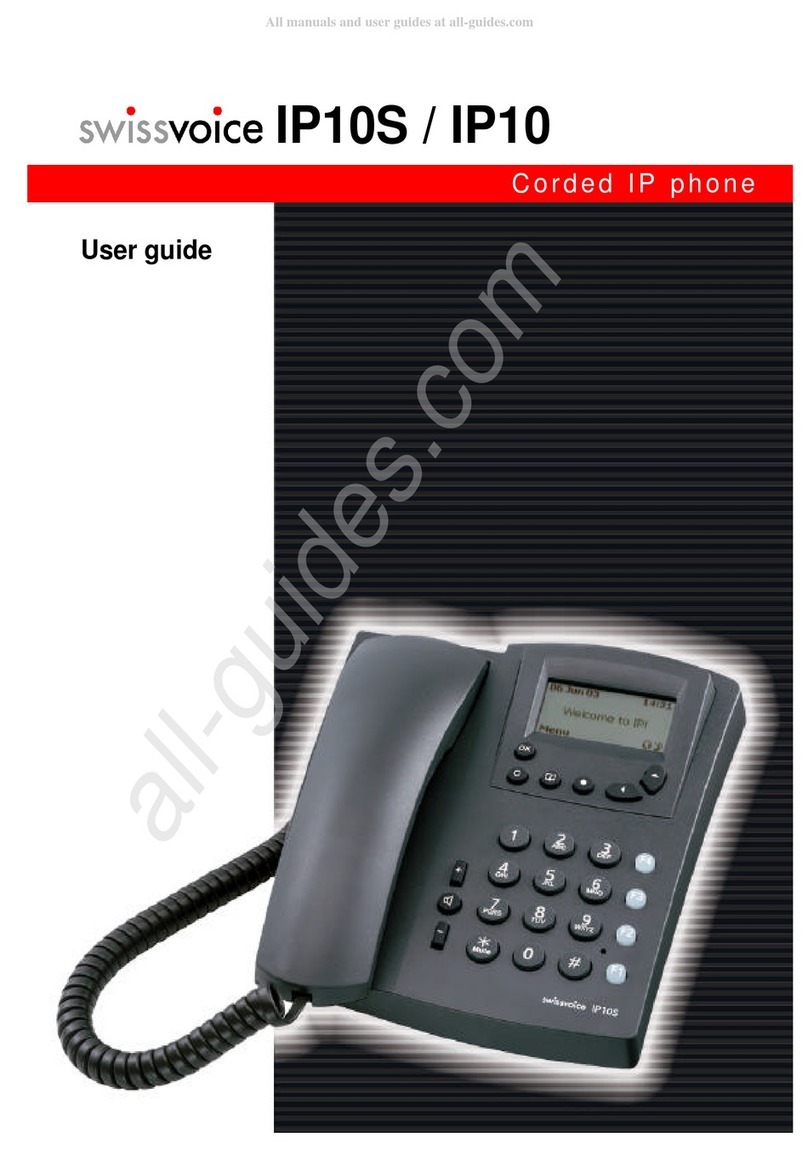
Swissvoice
Swissvoice IP10/S Series User manual

Swissvoice
Swissvoice BTouch User manual

Swissvoice
Swissvoice ePure TAM User manual

Swissvoice
Swissvoice IP10/S Series User manual
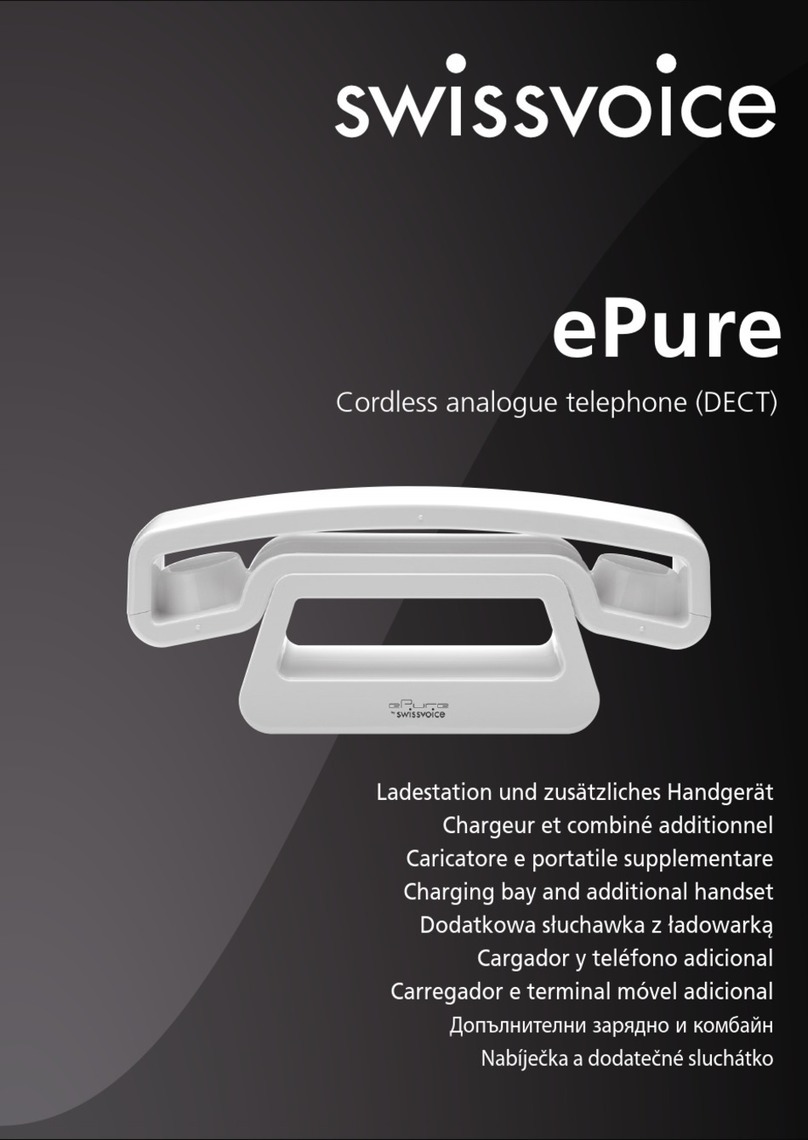
Swissvoice
Swissvoice ePure User manual
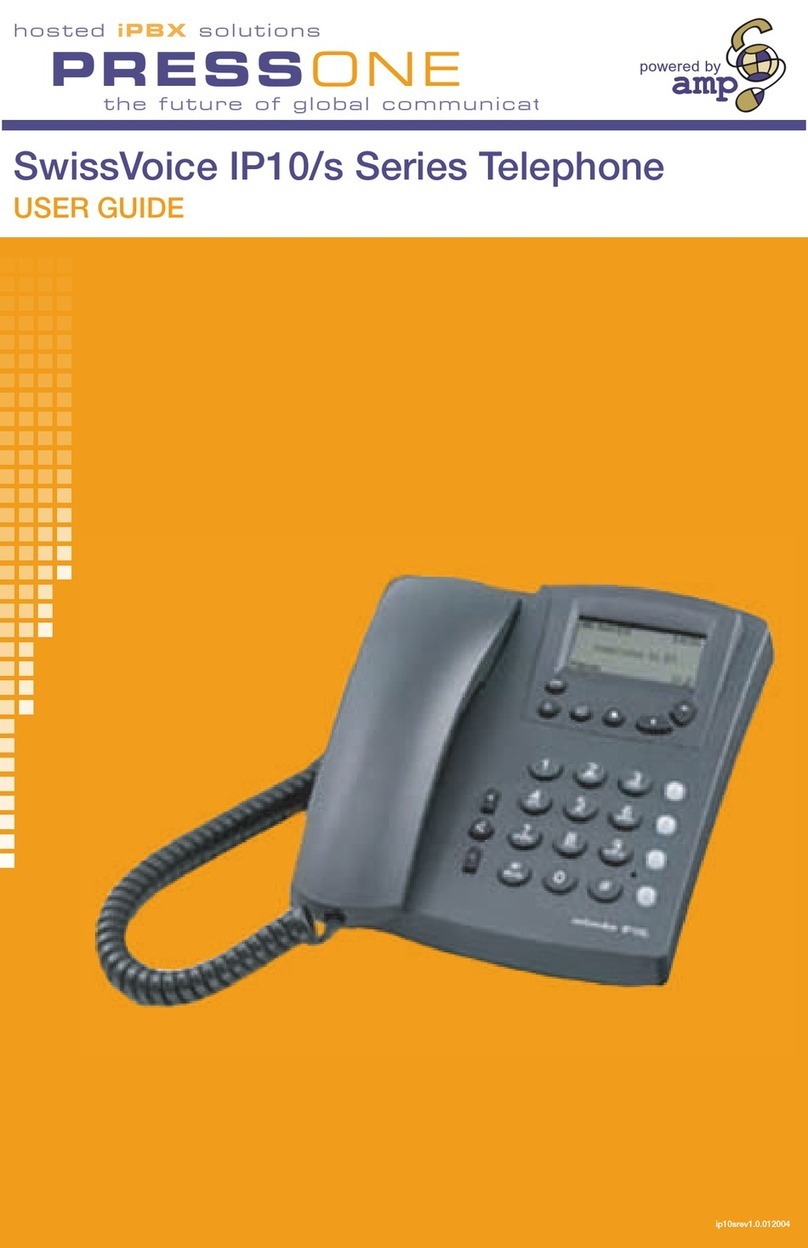
Swissvoice
Swissvoice IP-10 User manual
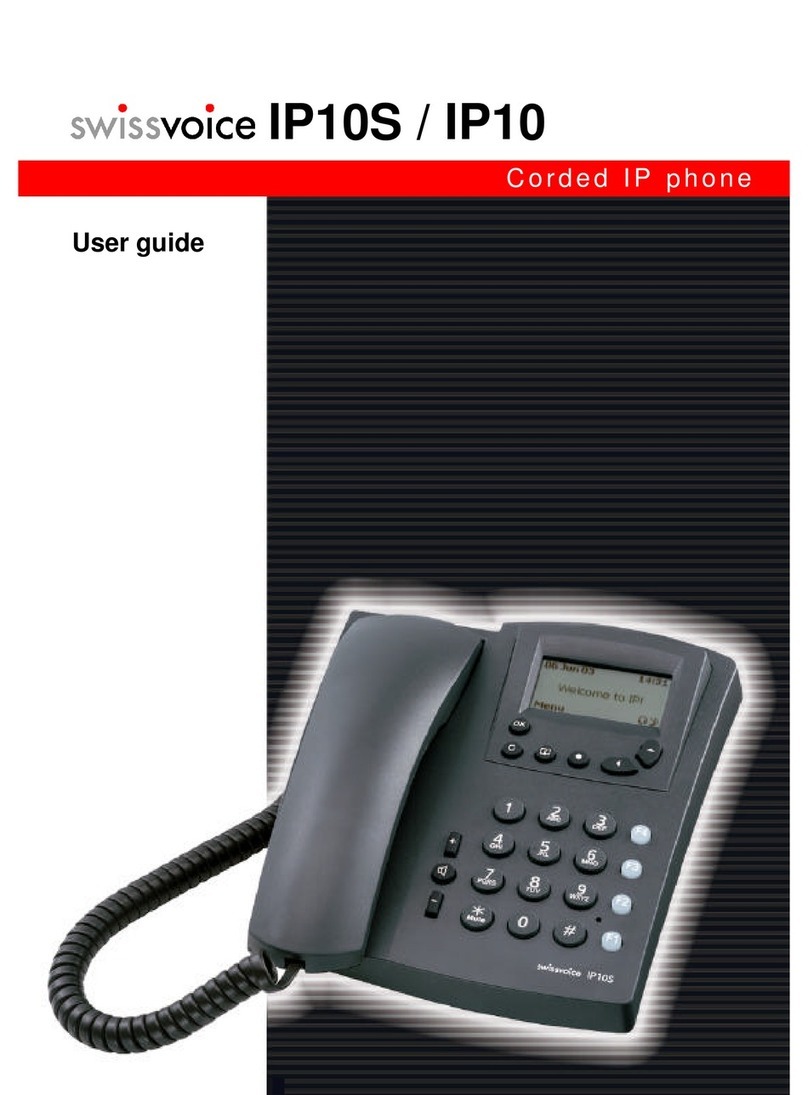
Swissvoice
Swissvoice IP-10 User manual
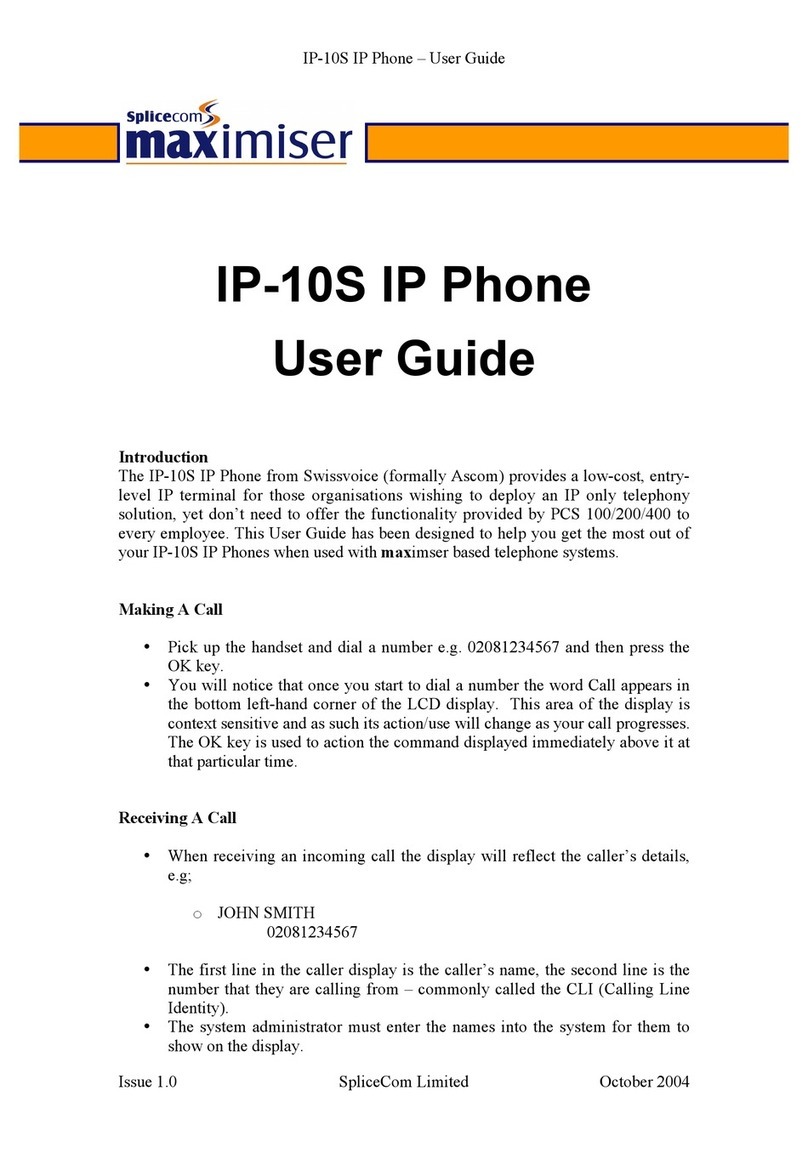
Swissvoice
Swissvoice IP10/S Series User manual
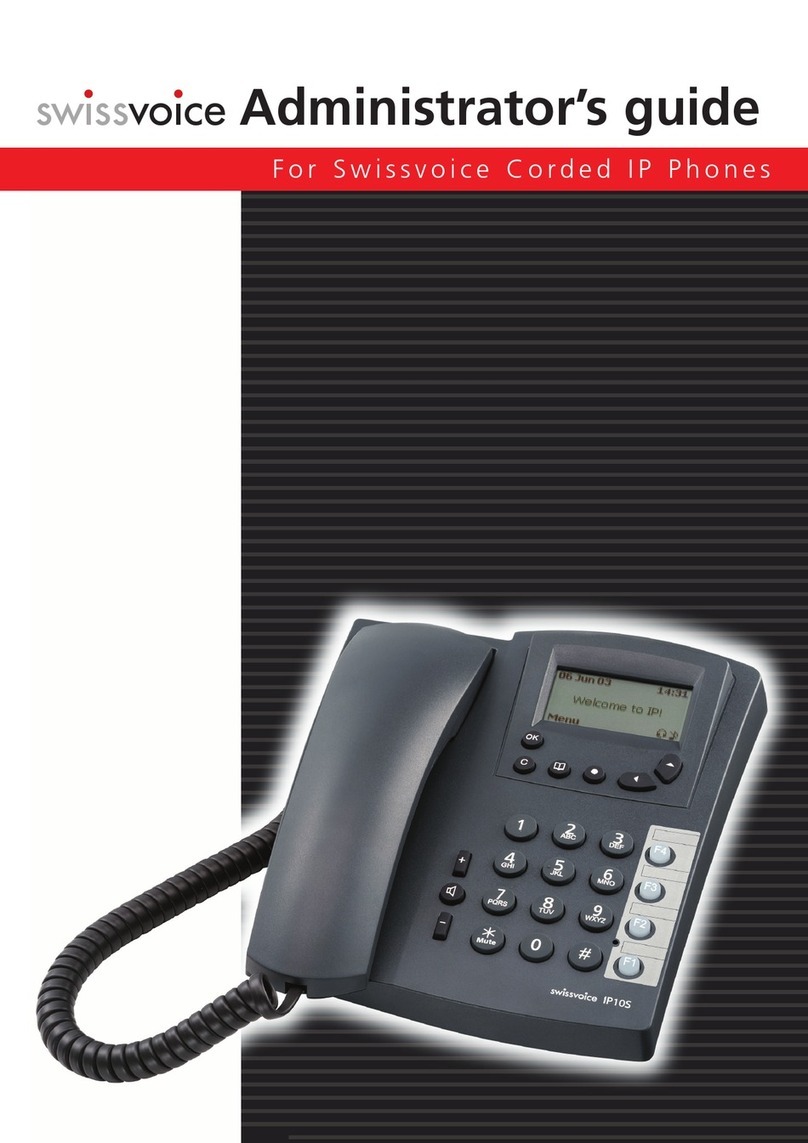
Swissvoice
Swissvoice Corded IP Phones Service manual
